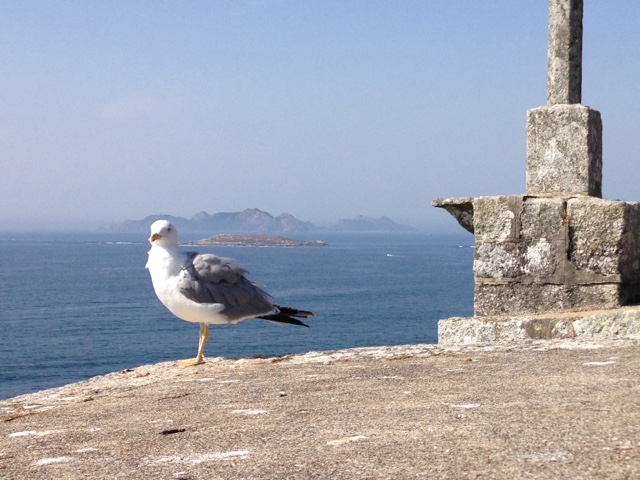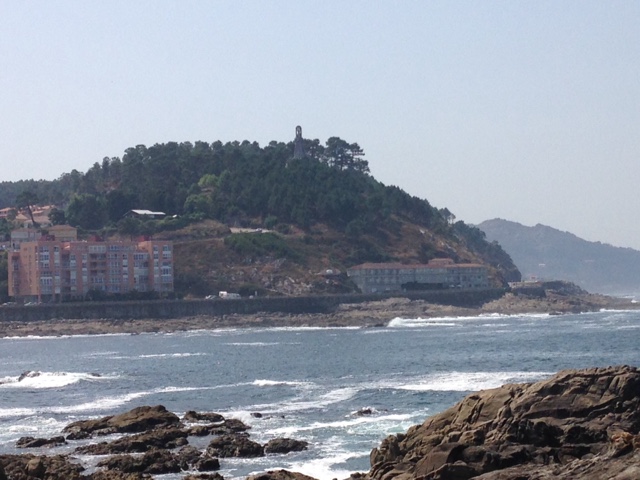Baiona is also known as Bayona, it is symptomatic of the rise of regional independence that the launguage changes so much, it is a small problem for us as we struggle to get to grips with a different launguage and in a hundred miles not only spelling but pronunciation changes. We were now in the last Ria before the border with Portugal and realistically the furthest south we would get this year. It is the end of the Rias Braxas, the southern rias.
I was keen to go ashore and visit the Pinta, as was Lynne having done the same voyage herself.
The Pinta was one of only two of Columbus's small fleet to return from the new world, allegedly the fastest of the three ships it was the first to return under the command of Martin Alonzo Pinzon. His brother Vincente was captain of the Nina, which Columbus sailed back in after the Santa Maria was lost on a reef. Pinzon actually returned to Spain whereas Columbus was unfortunate to land in Lisbon ( Portugal ) there has been some controversy ever since about the true relationship between the brothers Pinzon and Columbus and whether they should be credited with joint discovery of the New World. I tend to think they should, reading the diaries and accounts of the times ( albeit heavily redacted by Columbus ) it becomes obvious that Pinzon was evidently a superior seaman to Columbus.
The Pinta is 17 metres on deck ( 56 ft ), only 20 feet longer than Dark Tarn. However with a crew of 26 I think we probably have more personal space. We had been given MP3 players so that we could have a guided audio tour in English. This proved very interesting even though we constantly seemed to be ahead of the commentary!
The ship is set up with exibits, this is Pinzon himself with the navigational instruments of the day the cross staff and astrolabe, in principle exactly the same as the sextants we have on board, used for measuring the altitude of celestial objects.
Just behind Lynne in this photo is a representation of Rodrigo de Triana in the rigging who is credited with having the first sight of land in the new world, he can be seen pointing enthusiastically!
Soon it was time to move on to see some more history, namely the fortress on the rather grandly named Parador national Conde de Gondomar, the fortress is known more commonly as Monterreal.
It's possible to walk around the fortress at a low or high level, initially we took the longer ( 2 km ) lower route.
It provides some stunning views out towards Islas Cies and the bay of Baiona.
Some of the remains of fortifications are a bit of a mystery which only adds to their charm.
By the aid of strategically placed steps , rope handrails and the like it was possible to climb up and examine the different statues in various niches in the rock. A lot of effort had gone into it and continued as it was beautifully maintained.
Soon we were back in the harbour area, which was also one of the many beaches for the town.
Dark Tarn can be seen at anchor beyond the moored boats.
We decided to have a coffee and an ice cream before attempting the second circumnavigation of the fortress walls.
For the princely sum of 1€ we were allowed on to the battlements and could wander at will within the fortress walls, it's actually now the location of a rather posh hotel.
The views if anything got even better.
The town beaches and marinas could be seen and of course Dark Tarn out at anchor in the bay beyond.
There is as well as a hotel a rather good restaurant, but again rather rich for our blood and we contented ourselves with visual pleasures.
Of course we had to have the obligatory canon shot!
Here is rather a nice view of Islas Cies behind a tatty herring gull, the island about half way is part of the extensive reef that protects the bay to the north. You can detect the breakers to left and right.
Once more we returned to the harbour area and one more bit of climbing was required to see a sculpture which depicted the discovery of the new world.
We weren't quite sure what it was trying to say but we imagine Columbus is the one with the posh hat.
The following day we had one more tourist thing to do and that was to climb to the statue of the virgin that could be seen on a hill just to the west of town.
These are arranged to the side of the path and spiral up toward the summit.
The statue herself is very impressive and is made primarily of granite with the exception of the hands and face which are white marble.
It's possible to go inside and climb a tortuous spiral staircase to a viewing platform that can be seen on the boat held in the virgins right hand.
Also the platform itself is rather small, however the views are the best to be had.
The bay, Ria and town below.....
And of course the virgin herself.
As you descend around the back there is a very convenient cafe where we had a reviving coffee.
We had been pleasantly surprised by Baiona and would return again before leaving the Rias.
The hotel that has been built inside the fortress of Monterreal. Looks a little like Alcatraz but it really is very posh!

































No comments:
Post a Comment